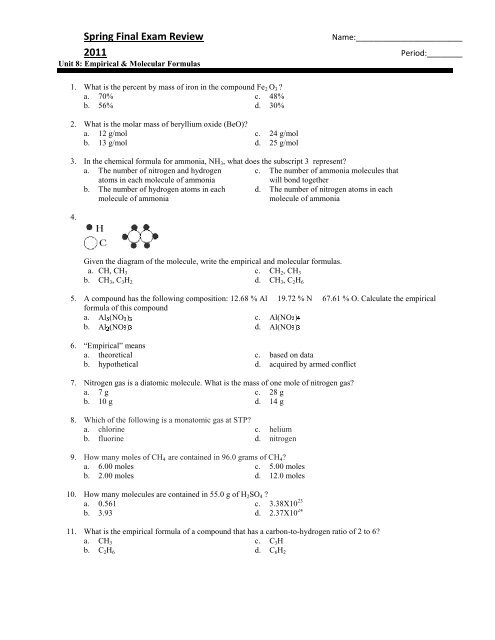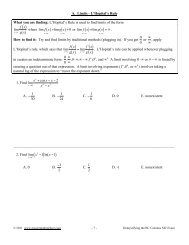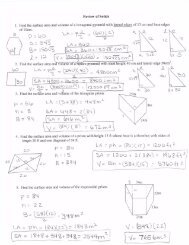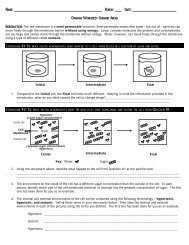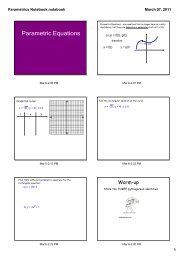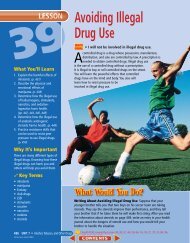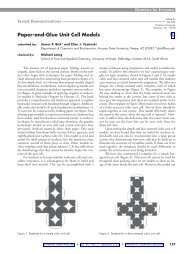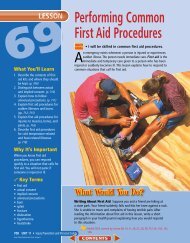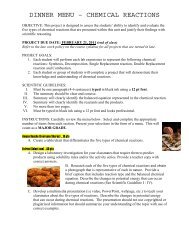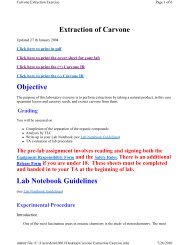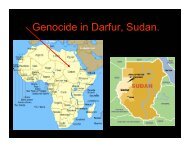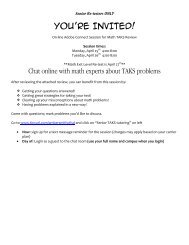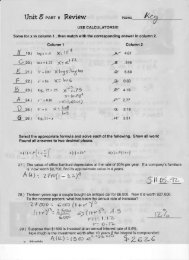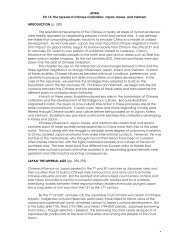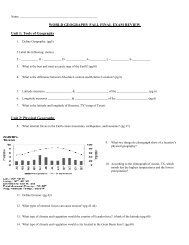Create successful ePaper yourself
Turn your PDF publications into a flip-book with our unique Google optimized e-Paper software.
Spring <strong>Final</strong> <strong>Exam</strong> Review Name:________________________<br />
2011 Period:________<br />
Unit 8: Empirical & Molecular Formulas<br />
1. What is the percent by mass of iron in the compound Fe2 O3 ?<br />
a. 70% c. 48%<br />
b. 56% d. 30%<br />
2. What is the molar mass of beryllium oxide (BeO)?<br />
a. 12 g/mol c. 24 g/mol<br />
b. 13 g/mol d. 25 g/mol<br />
3. In the chemical <strong>for</strong>mula <strong>for</strong> ammonia, NH3, what does the subscript 3 represent?<br />
a. The number of nitrogen and hydrogen c. The number of ammonia molecules that<br />
atoms in each molecule of ammonia<br />
will bond together<br />
b. The number of hydrogen atoms in each d. The number of nitrogen atoms in each<br />
molecule of ammonia<br />
molecule of ammonia<br />
4.<br />
Given the diagram of the molecule, write the empirical and molecular <strong>for</strong>mulas.<br />
a. CH, CH3 c. CH2, CH3<br />
b. CH3, C3H2 d. CH3, C2H6<br />
5. A compound has the following composition: 12.68 % Al 19.72 % N 67.61 % O. Calculate the empirical<br />
<strong>for</strong>mula of this compound<br />
a. Al (NO ) c. Al(NO )<br />
b. Al (NO ) d. Al(NO )<br />
6. “Empirical” means<br />
a. theoretical c. based on data<br />
b. hypothetical d. acquired by armed conflict<br />
7. Nitrogen gas is a diatomic molecule. What is the mass of one mole of nitrogen gas?<br />
a. 7 g c. 28 g<br />
b. 10 g d. 14 g<br />
8. Which of the following is a monatomic gas at STP?<br />
a. chlorine c. helium<br />
b. fluorine d. nitrogen<br />
9. How many moles of CH4 are contained in 96.0 grams of CH4?<br />
a. 6.00 moles c. 5.00 moles<br />
b. 2.00 moles d. 12.0 moles<br />
10. How many molecules are contained in 55.0 g of H2SO4 ?<br />
a. 0.561 c. 3.38X10 23<br />
b. 3.93 d. 2.37X10 24<br />
11. What is the empirical <strong>for</strong>mula of a compound that has a carbon-to-hydrogen ratio of 2 to 6?<br />
a. CH3 c. C3H<br />
b. C2H6 d. C6H2
12. Which <strong>for</strong>mula is both a molecular and an empirical <strong>for</strong>mula?<br />
a. C6H12O6 c. C3H8O<br />
b. C2H4O2 d. C4H8<br />
Unit 9 Ionic and Metallic Bonding<br />
13. The correct chemical <strong>for</strong>mula <strong>for</strong> iron(II) sulfide is<br />
a. FeS c. FeSO4<br />
b. Fe2S3 d. Fe2(SO4)3<br />
14. Elements from which two groups in the periodic table would most likely combine with each other to <strong>for</strong>m an<br />
ionic compound?<br />
a. 1 and 2 c. 1 and 17<br />
b. 16 and 17 d. 17 and 18<br />
15. A solid substance is an excellent conductor of electricity. The chemical bonds in this substance are most likely<br />
a. ionic, because the valence electrons are shared between atoms<br />
b. ionic, because the valence electrons are mobile<br />
c. metallic, because the valence electrons are stationary<br />
d. metallic, because the valence electrons are mobile<br />
16. The <strong>for</strong>mula <strong>for</strong> magnesium chloride is<br />
a. MgCl2 c. Mg2Cl3<br />
b. MnCl d. MnCl2<br />
17. Which is a unique characteristic of the bonding between metal atoms?<br />
a. Atoms require additional electrons to reach a stable octet.<br />
b. Atoms must give away electrons to reach a stable octet.<br />
c. Atoms share valence electrons only with neighboring atoms to reach a stable octet.<br />
d. Delocalized electrons move among many atoms creating a sea of electrons.<br />
18. The correct <strong>for</strong>mula of an ionic compound containing Al 3+ and CO3 2- is<br />
a. AlCO3 b. Al(CO3)3 c. Al2(CO3)3 d. Al3(CO3)2<br />
19. When naming a transition metal that has more than one oxidation number, the numeric value of the oxidation<br />
number is indicated by a<br />
a. Roman numeral c. subscript<br />
b. Greek prefix d. suffix<br />
20. Which substance contains bonds that involved the transfer of electrons from one atom to another?<br />
a. CO2 b. NH3 c. KBr d. Cl2<br />
21. Which have the lowest electronegativities?<br />
a. Group 1 metals c. Group 2 metals<br />
b. Group 7 d. transition metals<br />
22. When cations and anions join, they <strong>for</strong>m what kind of chemical bond?<br />
a. ionic b. hydrogen c. metallic d. covalent<br />
23. Cations are <strong>for</strong>med when neutral atoms lose ---<br />
a. electrons b. protons c. neutrons d. positrons<br />
24. When chlorine gas reacts with sodium metal, what type of substance is <strong>for</strong>med?<br />
a. a mixture c. an element<br />
b. a compound d. a solution
25. Which two substances cannot be broken down by a chemical change?<br />
a. C and CuO c. CO2 and CuO<br />
b. C and Cu d. CO2 and Cu<br />
26. Which list of <strong>for</strong>mulas represents compounds only?<br />
a. CO2, H2O, NH3 c. H2, Ne, NaCl<br />
b. H2, N2, O2 d. MgO, NaCl, O2<br />
27. An ionic compound is <strong>for</strong>med when there is a reaction between the elements<br />
a. strontium and chlorine c. nitrogen and oxygen<br />
b. hydrogen and chlorine d. sulfur and oxygen<br />
Chem Unit 10: Covalent Bonding<br />
28. Which pair of elements would most likely bond to <strong>for</strong>m a covalently bonded compound?<br />
a. sodium and fluorine c. phosphorus and oxygen<br />
b. barium and chlorine d. magnesium and sulfur<br />
29. In chemical compounds, covalent bonds <strong>for</strong>m when<br />
a. the electronegativity difference between two atoms is very large<br />
b. electrons are completely transferred between two metals<br />
c. pairs of electrons are shared between two nonmetal atoms<br />
d. two nonmetal ions are attracted to each other by opposite charges<br />
30. Which is the correct <strong>for</strong>mula <strong>for</strong> dinitrogen pentoxide?<br />
a. N4O b. NO2 c. N2O5 d. NO<br />
31. Which of the following is the name of the molecule PCl3?<br />
a. Phosphorus trichloride c. Potassium trichloride<br />
b. Phosphorus chloride d. Potassium chloride<br />
32. Given a <strong>for</strong>mula <strong>for</strong> oxygen gas: What is the total number of electrons shared between the atoms represented in<br />
this <strong>for</strong>mula?<br />
a. 1 b. 2 c. 8 d. 4<br />
33. What are shared in covalent bonds?<br />
a. Cations b. Protons c. Electrons d. Anions<br />
34. The <strong>for</strong>mula <strong>for</strong> dinitrogen tetroxide<br />
a. N2O4 b. N3O3 c. N2O d. NO<br />
35. What is the correct name <strong>for</strong> the compound P4O6?<br />
a. Phosphoric acid c. Phosphorus(IV) oxide<br />
b. Phosphorus oxide d. Tetraphosphorus hexoxide<br />
36. What is the total number of electrons shared in a double covalent bond between two atoms?<br />
a. 1 b. 2 c. 8 d. 4<br />
37. Which statement describes what occurs as two atoms of bromine combine to become a molecule of bromine?<br />
a. Energy is absorbed as a bond is <strong>for</strong>med.<br />
b. Energy is absorbed as a bond is broken.<br />
c. Energy is released as a bond is <strong>for</strong>med.<br />
d. Energy is released as a bond is broken.<br />
Unit 11: Chemical Reactions
38. Some chemical reactions absorb energy, while others release energy. Of the chemical reactions in burning coal<br />
and exploding fireworks, which will release energy?<br />
a. Burning coal only<br />
b. Exploding fireworks only<br />
c. Both burning coal and exploding fireworks<br />
d. Neither burning coal nor exploding fireworks<br />
39. Given the balanced equation representing a reaction: CH4(g) + 2O2(g) 2 H2O(g) + CO2(g) + energy<br />
Which statement is true about energy in this reaction?<br />
a. The reaction is exothermic because it releases energy.<br />
b. The reaction is exothermic because it absorbs energy.<br />
c. The reaction is endothermic because it releases energy.<br />
d. The reaction is endothermic because it absorbs energy.<br />
40. A catalyst lowers the activation energy of a reaction by<br />
a. providing an alternate reaction pathway<br />
b. decreasing the heat of reaction<br />
c. increasing the mass of the reactants<br />
d. changing the mole ratio of the reactants<br />
41. Which statement explains why the speed of some reactions is increased when the surface area of one or all the<br />
reactants is increased?<br />
a. increasing surface area changes the electronegativity of the reactant particles<br />
b. increasing surface area changes the concentration of the reactant particles<br />
c. increasing surface area changes the conductivity of reactant particles<br />
d. increasing surface area enables more reactant particles to collide<br />
42.<br />
The general equation shown is a reaction that is an<br />
a. exothermic decomposition c. endothermic synthesis<br />
b. endothermic decomposition d. exothermic synthesis<br />
43. During all chemical reactions, mass, energy, and charge are<br />
a. absorbed c. <strong>for</strong>med<br />
b. conserved d. released<br />
44. Consider this reaction: NH3(g) + HCl(g) NH4Cl(s)<br />
Which type of reaction does this equation represent?<br />
a. combustion c. single-replacement<br />
b. decomposition d. synthesis<br />
45.<br />
The type of reaction represented by the above equation is--<br />
a. single replacement c. decomposition<br />
b. double replacement d. synthesis
46. The appropriate model <strong>for</strong> a decomposition reaction is<br />
47.<br />
a.<br />
b.<br />
What type of reaction does this illustration represent?<br />
a. Decomposition c. Single-replacement<br />
b. Synthesis d. Double-replacement<br />
48. Which of these is the general <strong>for</strong>mula <strong>for</strong> a double-replacement reaction?<br />
a. A + B AB<br />
b. AB + XY BA + YX<br />
c. AB + XY AY + XB<br />
d. A + B + XY AX + BY<br />
49. ____H2O ____H2 + ____O2<br />
The coefficients <strong>for</strong> the correctly balanced equation <strong>for</strong> the reaction illustrated above are...<br />
a. 1, 1, 1 c. 2, 1, 2<br />
b. 1, 1, 2 d. 2, 2, 1<br />
50. A balanced chemical equation has equal numbers of atoms of each type on both sides of the equation. This<br />
illustrates the principle of<br />
a. conservation of energy<br />
b. conservation of mass<br />
c. action and reaction<br />
d. natural selection<br />
51. 4P + 5O2 2P2Ox<br />
The subscript of oxygen in the product should be -<br />
a. 2 c. 10<br />
b. 5 d. 20<br />
52. Which reaction diagram shows the effect of using the appropriate catalyst in a chemical reaction?<br />
a.<br />
c.<br />
d.<br />
c.
.<br />
53. Which term refers to the difference between the potential energy of the products and the potential energy of the<br />
reactants <strong>for</strong> any chemical change?<br />
a. heat of deposition c. heat of reaction<br />
b. heat of fusion d. heat of vaporization<br />
54. Given the balanced equation representing a reaction: 2HCl(aq) + Na2S2O3(aq) S(s) + H2SO3(aq) + 2NaCl(aq)<br />
Decreasing the concentration of Na2S2O3(aq) decreases the rate of reaction because the<br />
a. activation energy decreases.<br />
b. activation energy increases.<br />
c. frequency of effective collisions decreases.<br />
d. frequency of effective collisions increases.<br />
CHEMISTRY<br />
STOICHIOMETRY<br />
55. Metallic sodium reacts violently with water to <strong>for</strong>m hydrogen and sodium hydroxide according to the balanced<br />
equation: 2Na + 2H2O 2NaOH + H2<br />
How many moles of hydrogen gas are generated when 4.0 moles of sodium react with excess water?<br />
a. 1.0 mole c. 3.0 moles<br />
b. 2.0 moles d. 4.0 moles<br />
56. W+X Y+Z+60 kJ<br />
How many moles of product Z will be <strong>for</strong>med if 120 kJ of heat was given off in the reaction shown?<br />
a. 2.0 moles c. 3.0 moles<br />
b. 0.50 moles d. 4.0 moles<br />
57. Mg + ZnCl2 MgCl2 + Zn<br />
15 moles of magnesium are reacted with 5 moles of zinc chloride. Which reactant is limiting?<br />
58.<br />
a. Zn c. ZnCl2<br />
b. MgCl2 d. Mg<br />
How many liters of oxygen are required to produce 2 liters of water at STP?<br />
a. 1 c. 3<br />
b. 2 d. 4<br />
d.<br />
59. W+X Y+Z<br />
How many grams of product Z will be <strong>for</strong>med if 12.0 g of W react with 10.0 g of X to <strong>for</strong>m 8.0 g of product Y in<br />
the reaction shown?<br />
a. 8.0 g c. 12.0 g<br />
b. 10.0 g d. 14.0 g
60.<br />
How many moles of hydrogen gas are produced when 0.066 mole of sodium is completely reacted?<br />
a. 0.022 mol H2 c. 0.066 mol H2<br />
b. 0.033 mol H2 d. 0.099 mol H2<br />
61. Hydrogen chloride can be <strong>for</strong>med from hydrogen and chlorine as shown in the reaction.<br />
H2 + Cl2 2HCl + heat<br />
Chlorine and fluorine are located in the same group in the periodic table. If the reaction were per<strong>for</strong>med with<br />
fluorine instead of chlorine, how many mole of H2 would be required to balance the equation?<br />
a. 1 c. 4<br />
b. 2 d. 8<br />
Consider the diagram below. In the box below left is a mixture of sulfur dioxide gas and<br />
oxygen gas. The box below right shows the contents after the reaction is complete.<br />
62. Which of the equations below best represents the reaction between sulfur dioxide and oxygen gases?<br />
a. SO2 + O2 SO3<br />
b. 2 SO2 + O2 2 SO3<br />
c. 4 SO2 + 4 O2 4 SO3 + 2 O2<br />
d. SO2 + 2 O2 SO3<br />
63. Which is the limiting reactant?<br />
a. SO2 c. SO3<br />
b. O2 d. none of these is limiting<br />
Acids and Bases<br />
64. Which of the following is an observable property of an acid?<br />
a. They become slippery when reacting with water.<br />
b. They react with metals to release hydrogen gas.<br />
c. They produce salts when mixed with other acids.<br />
d. They become more acidic when mixed with a base.<br />
65. What is the pOH of a solution of KOH with a hydroxide concentration of [OH - ] = 1 x 10 -4 ?<br />
a. -10 c. 4<br />
b. -4 d. 10<br />
66. Potassium hydroxide (KOH) is a strong base because it<br />
a. easily releases hydroxide ions c. does not dissolve in water.<br />
b. reacts to <strong>for</strong>m salt crystals in water. d. does not conduct an electric current.<br />
67. Of four different laboratory solutions, the solution with the highest acidity has a pH of<br />
a. 11 c. 5<br />
b. 7 d. 3
68. Which word equation represents a neutralization reaction?<br />
a. base + acid salt + water<br />
b. base + salt water + acid<br />
c. salt + acid base + water<br />
d. salt + water acid + base<br />
69. A water molecule acts as an acid when the water molecule<br />
a. accepts an H+ c. donates an H+<br />
b. accepts an OH- d. donates an OH-<br />
70. Which of the following is the correct name <strong>for</strong> the acid identified by the <strong>for</strong>mula HCl?<br />
a. Hydrochloric acid c. Chloric acid<br />
b. Chlorous acid d. Perchloric acid<br />
71. Ulcers are often caused by an excess of stomach acid. Milk of magnesia is often used to soothe the irritation.<br />
Milk of magnesia is probably<br />
a. an acid c. an indicator<br />
b. a base d. a colloid<br />
72. Phenophthalein is an indicator that turns pink when added to a basic solution. In which solution would<br />
phenolphthalein turn pink?<br />
a. NaOH c. H2O<br />
b. HCl d. NaCl<br />
73. In a titration experiment, if 30.0 mL of an HCl solution reacts with 24.6 mL of a 0.50-M NaOH solution, what is<br />
the concentration of the HCl solution?<br />
a. 0.41 M c. 1.5 M<br />
b. 0.61 M d. 370 M<br />
74. What does pH measure?<br />
a. Hydrogen ion concentration c. Acid density<br />
b. Hydroxide ion concentration d. Base density<br />
75. When a base is mixed with an acidic solution, neutralization occurs because the<br />
a. base reaches absolute zero c. base chemically reacts with the acid<br />
b. acid evaporates d. mass of the solution increases<br />
76. Equal volumes of 1 molar hydrochloric acid (HCl) and 1 molar sodium hydroxide base (NaOH) are mixed. After<br />
mixing, the solution will be<br />
a. strongly acidic c. nearly neutral<br />
b. weakly acidic d. weakly basic<br />
77. An aqueous solution of lithium hydroxide contains hydroxide ions as the only negative ion in the solution.<br />
Lithium hydroxide is classified as an<br />
a. aldehyde c. acid<br />
b. alcohol d. base<br />
78. One acid-base theory defines a base as an<br />
a. H+ donor c. H donor<br />
b. H+ acceptor d. H acceptor<br />
79. During which process can 10.0 milliliters of a 0.05 M HCl(aq) solution be used to determine the unknown<br />
concentration of a given volume of NaOH(aq) solution?<br />
a. evaporation c. filtration<br />
b. distillation d. titration
80. A solution having an equal number of H + ions and OH - ions will have a pH of<br />
a. 3 c. 9<br />
b. 7 d. 11<br />
Unit 15: Redox Reactions<br />
81. Consider this chemical reaction: 2AgBr(s) + energy 2Ag(s) + Br2(l)<br />
Which is true about the reaction?<br />
a. Silver is reduced. c. Silver loses electrons.<br />
b. Bromine is reduced. d. Bromine gains electrons.<br />
82. In HNO3, the oxidation state of hydrogen is +1 and the oxidation state of oxygen is -2. There<strong>for</strong>e, the oxidation<br />
state of nitrogen is --<br />
a. -1 c. +4<br />
b. +3 d. +5<br />
83. Given the balanced ionic equation representing a reaction: 2Al 3+ (aq) + 3Mg(s) 3Mg 2+ (aq) + 3Al(s)<br />
In this reaction, electrons are transferred from<br />
a. Al to Mg 2+ c. Mg to Al 3+<br />
b. Al 3+ to Mg d. Mg 2+ to Al<br />
84. Which equation represents an oxidation-reduction reaction?<br />
a. Na + Cl2 NaCl<br />
b. H2SO4 + Ca(OH)2 CaSO4 + 2H2O<br />
c. MgCrO4 + BaCl2 MgCl2 + BaCrO4<br />
d. Zn(NO3)2 +Na2CO3 2NaNO3 + ZnCO3<br />
85. Given the balanced equation representing a reaction: 2KClO3(s) 2KCl(s) + 3O2(g)<br />
The oxidation state of chlorine in this reaction changes from<br />
a. -1 to +1 c. +1 to -1<br />
b. -1 to +5 d. +5 to -1


